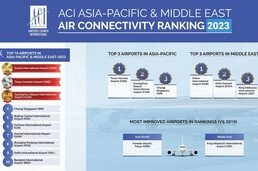
Middle East Leads the way with +26% Growth in Total Air Connectivity in 2022
- 2023-09-19
- Total Air Connectivity in Asia-Pacific in 2022 recorded a drop of -38% vs 2019 levels but it is leading towards recovery
- Dubai International Airport retains No.1 ranking and Doha Hamad Airport is second in Total Connectivity ranking in 2022 across Asia-Pacific and Middle East. Tokyo Haneda Airport is at No.3
- Dubai Airport and Incheon Airport leads the preliminary direct connectivity ranking for 2023 in Middle East and Asia-Pacific, respectively
Airports Council International (ACI) Asia-Pacific and Middle East (ACI APAC & MID) announced the Airport Connectivity Report at the launch of its Middle East office in Riyadh.
Developed in partnership with PwC, the Airport Connectivity Report measures passengers’ ability to access the global air transport network, capturing both direct and indirect routes, and also factoring in the quality of service of each connection, such as destination choice, service frequency, onward connectivity and price, contributing to the passenger experience. The report covers a sample of 100 airports that accounts for almost 60% of the combined passenger traffic in Asia-Pacific and the Middle East in 2019.

The Report reveals that air connectivity in the Middle East stands out with +26% growth in total connectivity in 2022 vs 2019, with direct connectivity to destinations in North America, Asia-Pacific and Africa witnessing the strongest recovery post COVID 19, with Low-Cost Carriers (LCCs) driving the growth. On the contrary, Asia-Pacific has seen a decline in air connectivity by -38% in the same period.
Several key factors contribute to the decline in air connectivity, including extended travel restrictions due to COVID-19, limitations on air traffic rights, constraints on airport slots, rising airfares, economic downturns, and geopolitical tensions. This decline in air connectivity, coupled with increasing airfares, illustrates its negative impact on the recovery of air travel and the resultant inconvenience to passengers. From the passenger’s perspective, connectivity is essential for mobility, providing significant economic and social advantages. Nevertheless, preliminary rankings for 2023 suggest a positive outlook for the region.
Key Observations
The Last Region to Recover: Direct connectivity from APAC to other regions was still lagging behind as of 2022, although Low-Cost Carrier’s are driving capacity growth. Airports with annual passenger volumes of 1 to 40 MPPA led the recovery, while larger airports were impacted by China's Zero-COVID strategy with a blanket ban on international travel. Middle-sized airports, such as King Khalid International Airport (Riyadh) with a +75% recovery and Hamad International Airport (DOH) with a +42%, stood out. Preliminary 2023 connectivity rankings show significant improvements in seat capacity to China from selected 100 airports, rebounding by a remarkable +937% in August 2023 compared to August 2022, but still with a large margin to grow in 2024.
Advantages of Air Transport Liberalisation: The gradual liberalisation of the aviation industry in the Asia-Pacific and Middle East regions has been a boon for the sector. Singapore has been particularly active in air liberalisation, enjoying benefits such as reduced airfares and a strong passenger traffic base. This success is attributed to a high market share of foreign airlines, extensive international routes, numerous air service agreements, and a streamlined visa policy. Recently, ASEAN has emerged as the most proactive aviation bloc in promoting air liberalisation. It has been focusing on both internal liberalisation among its member states and broader agreements, such as the EU-ASEAN bloc-to-bloc initiative. However, there are some key aviation markets such as Australia, Indonesia, and the Philippines that could benefit from the further liberalisation of the market.
Impact of Increasing Airfares
The cost of travel from the selected Asia-Pacific and Middle Eastern airports has increased by up to 50%, threatening the recovery of the industry, according to our recent study on airfares. 69 out of the selected 100 airports experienced a decrease in airfare affordability, which correlates with the airports’ decrease in available flights, routes, and seat capacities. Measured by average airfare in relation to per-capita income, air transport became 34% less affordable across the two regions.
Economic Impact of Aviation
Aviation plays a key role in socio-economic development by attracting foreign investment, supporting international trade and tourism, and creating jobs. In the Asia-Pacific, it contributed $1 trillion (3.3% of GDP) and employed 56 million people, while in the Middle East, the sector generated $260 billion (9.5% of GDP) and employed 4.6 million. Regression analysis confirms a correlation between GDP and seat capacity. Specifically, a 10% increase in seat capacity is linked to short-term GDP growth of 3 to 3.8% in the Asia-Pacific and 6.4% in the Middle East.
Large margins for the increase in propensity to fly and macroeconomic factors suggest a robust outlook for Connectivity
If Macao, Hong Kong, and Singapore topped the list in 2019, 2022 saw Oceania countries like French Polynesia, Australia, and New Zealand, along with Middle Eastern countries' such as Qatar, the UAE, and Bahrain at the forefront. On the contrary, key aviation markets like China and India, along with fast-growing markets such as the Philippines and Vietnam, have much lower flying propensity than Europe and North America. Favourable factors like GDP growth, large populations, a rising middle class, and ramping e-commerce position Asia-Pacific and the Middle East for long-term air connectivity growth between 2030-2040. However, there is a need for infrastructure development and the easing of airspace congestion to accommodate the expected growth in traffic.
Commenting on the release of the study, Mr. Stefano Baronci, the Director General of ACI Asia-Pacific & Middle East said: “This study provides an invaluable tool to the industry and policy makers to adopt the use of air connectivity indicators to appraise the performance and sustainable development of the aviation industry and its economic and social impact on countries. In addition, it also shows how to prioritise positive outcomes for consumers rather than simply focusing on the price-determination function for the benefit of all aviation stakeholders and the travelling public. The next step will be for ACI Asia-Pacific & Middle East to work closely with each government to promote aviation market liberalisation, visa simplification, investment in the development of infrastructure with a focus on the environment, and innovation of services.”
Recommendations to improve Connectivity
- Liberalise traffic rights to enhance connectivity and offer passengers affordable airfares, more choices, and superior service quality.
- Increase airlines’ seat capacity, recover and develop routes, and pursue reasonable pricing policies.
- Continue to modernise the slot allocation system, such as disincentivising slot misuse, increasing slot performance, and opening the market to more competition.
- Flexibility to set airport charges to invest in infrastructure and passenger-friendly amenities
- Reducing visa restrictions to facilitate international travel.
- Taking actions to reduce CO2 emissions at the airport towards the net zero goal.
- CATEGORY
- COUNTRY / AREA
- Hong Kong SAR
- AUTHOR
- ACI Asia-Pacific and Middle East







